Monarchs and locusts - champion insect migrants
 Many
of you who read last week's article on bird migration in this page may
have been amazed at the ability our feathered friends have to fly such
long distances. As we explained, animal migration is indeed a
fascinating aspect of life many scientists are trying to understand. Many
of you who read last week's article on bird migration in this page may
have been amazed at the ability our feathered friends have to fly such
long distances. As we explained, animal migration is indeed a
fascinating aspect of life many scientists are trying to understand.
In today's article, we will examine yet another segment of creatures
from the animal kingdom that go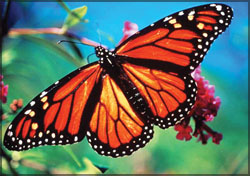 globetrotting...
globetrotting...
Like our feathered friends, many species of insects too migrate for
various reasons. You may find it hard to believe that insects, though
small in size and fragile-looking, undertake some of the toughest
migrations on record. Among insects, the best known migrants are the
butterflies and locusts.
Much studies have been carried out on insect migrations and many
discoveries have been made. Migrating insects provide researchers with a
living biological barometer; they provide clues about the state of the
environment over the range of migration.
According to them, three types of migration are done; they are one
way journeys to breed, journeys from breeding area to feeding area, and
journeys from breeding area to hibernation.
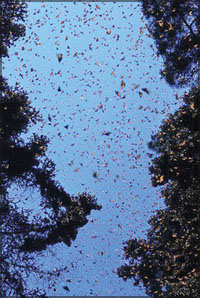 Of
all the insect migrations that have been studied, the most amount of
research has been done on the spectacular migration of Monarch
butterflies, which are also known as milkweeds, because it is their host
plant. Of
all the insect migrations that have been studied, the most amount of
research has been done on the spectacular migration of Monarch
butterflies, which are also known as milkweeds, because it is their host
plant.
These large, slow moving, orange hued butterflies found across much
of North America in the summer make a long, long journey to their over
wintering grounds in the south in enormous flocks amounting to millions.
At the onset of autumn, the butterflies could be seen flying to Florida,
Southern California, Mexico, the West Indies and Central America.
The Monarchs that live in South America fly even further south.
Despite their fragile form, Monarchs can attain flying speeds of up to
15 km (9 miles) per hour and cover immense distances. They are believed
to make a journey that covers a distance of 3,400 km or more.
How do these butterflies know when to migrate? Many factors such as
the change in the number of daylight hours and fluctuating temperature
are cues for them to move to warmer areas. The changes that take place
in their host plant, the milkweed, also signals them that it's time to
move. (The milkweed begins to turn yellow and dries up as the
temperature gets colder).
At their winter destinations, Monarch butterflies settle on vast
numbers on the branches of evergreen trees.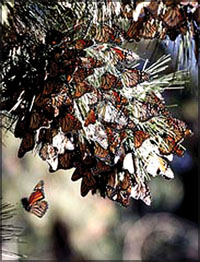 Here they remain in a torpid (slow moving or motionless) state
throughout the winter. In the spring, the butterflies that have survived
the winter, once again begin their journey back north, to their summer
grounds.
Here they remain in a torpid (slow moving or motionless) state
throughout the winter. In the spring, the butterflies that have survived
the winter, once again begin their journey back north, to their summer
grounds.
What's interesting about the migration of monarch butterflies is that
on the way they breed, sometimes passing through as many as three
generations. Individuals make the trip once; their children's
grandchildren return south in the following winter.
Amazingly, the butterflies fly in masses to the same winter roosts,
often to the exact same tree. How do they know where to go and which
tree to roost on? No one really understands how their homing system
works, but it is obvious that it is a completely inherited pattern of
responses, because there are no opportunities for learned behaviour.
Researchers have noted that migrating insects, or in this case the
butterflies, generally fly in a straight line. When meeting obstacles,
rather than deviate to the left or right, they fly over it.
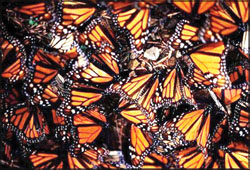 On
what do these migrant butterflies survive? It is believed that the fat
stored in their abdomen is a critical element for survival in winter. On
what do these migrant butterflies survive? It is believed that the fat
stored in their abdomen is a critical element for survival in winter.
This fat must not only fuel their flight, but also must last until
the next spring, when they begin their flight back. Most Monarchs
migrating southwards, stop to sip nectar and gain weight on the way.
Destructive migrants
Another major group of insects that migrate are the desert locusts.
Unlike the beautiful Monarch butterflies, locusts cause a lot of damage
to crops when migrating. In fact, they have become a pest to many
nations who are now looking for ways to control the damage caused by
swarms of locusts.
Even though a locust weighs only about two grammes, it eats its own
weight in food everyday. Imagine millions of them congregated in a grain
field, and the damage such a huge swarm could cause.
According to Food and Agriculture Organisation (FAO) officials, one
ton of locusts can eat as much food as 2,500 people! So, desert locusts are a threat to the agriculture of many
countries in Africa, Asia Minor and Western Asia.
2,500 people! So, desert locusts are a threat to the agriculture of many
countries in Africa, Asia Minor and Western Asia.
What you would be surprised to learn is that most of the time, this
destructive desert locust lives as a harmless grasshopper. It lives a
solitary life doing no harm, laying eggs that hatch into fresh
generations of normal grasshoppers; wingless at first and gradually
developing wings as they mature into adults.
What makes them destructive desert locusts then? Confinement to
limited amount of breeding grounds due to environmental conditions. When
this happens, the juveniles (young) begin to form groups.
These groups form even larger ones and eventually a huge army! What's
more, by this time the harmless, little grasshoppers have become
gregarious (living in flocks) yellow grasshoppers and even developed
longer than normal wings which enable them to fly farther and faster.
These huge swarms of locusts fly long distances, even across
continents in search of food. In fact, the longest insect migration
recorded is that of a desert locust amounting to about 4,500 km, wayback
in 1988.
|

The two types of locust |
Once these locusts are airborne, they fly swiftly through the skies
in vast clouds. They are generally guided by the wind and the Sun.
However, these swarms of locusts, which could contain millions of
individuals, could break up due to weather fluctuations. And when eggs
from these locusts hatch, they could be normal grasshoppers, once again.
It is not only Monarch butterflies and grasshoppers that migrate.
Many other species of butterflies and insects also do. For instance, the
Green Darner dragonfly makes a journey that can exceed 3,000 kilometres
from Manitoba to Texas. It takes two generations of dragonflies to
complete the journey.
The migration of dragonflies is less understood when compared with
that of monarchs and locusts. However, it is an established fact that
they commence their journey to warmer areas in late summer.
They find their way using natural landscape features such as sea
coasts and large rivers. Migration takes place in large swarms, with no
actual leader. It seems these insects generally follow the passage of
cold fronts when migrating.
when migrating.
One thing that becomes very clear when looking into migration
patterns of animals, especially insects and birds, is that the weather
plays a key role. Climate change therefore could have a drastic impact
on migration.
This could force them to either change their over wintering sites or
to adapt to the changes in their own environment. The ultimate fate
would be their total destruction. So, as all kinds of animals are needed
to maintain the ecological balance, we must pay more attention to the
impact our careless actions could have on the climate.
Find out more interesting facts about insect migration.
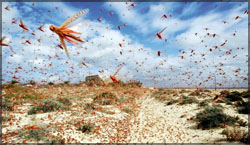 We
too will enlighten you on this subject in our future issues, as we still
have not dealt with fish, mammal and other animal migrations. We
too will enlighten you on this subject in our future issues, as we still
have not dealt with fish, mammal and other animal migrations.
****
Fact File
* There are four kinds of insect migration and two are known as
dynamic migration and homeostatic migration. The desert locust is a
dynamic migrator while the monarch falls into the latter category
Dynamic migration is directed
movement controlled by tides or wind, with navigational abilities not
essential.
Homeostatic migration
is a two way movement with migrant or offspring returning to breeding
areas, hence the need for navigational abilities. |
